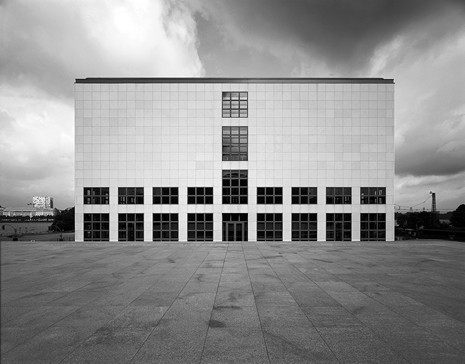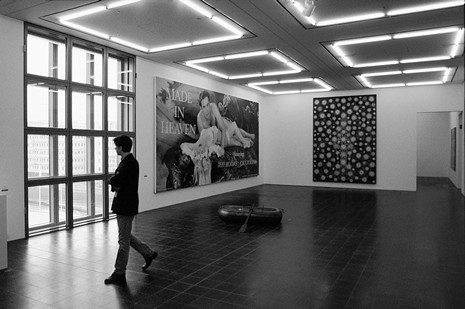Description
The cubic solitaire is to be adjudged not only as an incarnation of the pronounced ideas on architectural theory that Oswald Mathias Ungers has long since developed, but to the same extent as the result of intensive analysis of the urban spatial conditions. It was the task of the architect to supplement the two existing parts of the Hamburger Kunsthalle with a Galerie der Gegenwart. The Kunsthalle was built of brick in 1863-69 by Georg Theodor Schirrmacher in Neo Renaissance forms; in 1912-19, Alfred Erben added to it a massive extension ending in a rotunda crowned by a cupola. In the northern extension of the axis of these two buildings, on a building site surrounded on three sides by streets and railways, Ungers shifts his new building to the outermost edge and puts it onto a bevelled plinth of red granite that raises the ensemble above the roar of traffic (thus reminding us of the city wall that once ran along there) and lends it the appearance of a museum island. The empty space – precisely calculated to correspond exactly to the quadratic ground plan of the new volume – between it and the old building allows not only the richly decorated façade of the old Kunsthalle to be shown off to good effect, but also the monumental impact and urban dominance of the Galerie der Gegenwart coated with white Muschelkalk. The archaic-seeming pyramid-shaped plinth lends the light-coloured cube (which grows out of it) calculated pathos – a deliberate reference both to Schinkel’s design for Schloss Orianda in the Crimea, which is crowned by a radiant museum temple above massive plinths, and to the visionary project of French revolutionary architecture operating with purely geometric volumes. The intention of aiming at the sublime also applies to Ungers’ project, and the widespread dislike occasioned by this project is seen, evidently rightly, as evidence of the inability of our time to deal with the aesthetic category of the sublime.
Compositional laws of body and space contained in logical geometric systems – laws which Ungers, in his efforts to achieve a new abstraction and order in architecture, in the end traces back to the square that he conceives of as an indicator of reason overstepping nature’s ways of building – are demonstrated in an exemplary fashion in his museum in Hamburg. Both the relationship of the built volume to the undeveloped area and its spatial and façade articulation adopt a rhythm based on a square grid, each side 10 meters long. Through the windows, differentiated from storey to storey within this grid and ascending to the eaves line only in the central axis of all four similar façades, arises a balanced tension that is already set up in the proportioning of the volume itself. Starting with the idea of enclosing a central volume covered by a gable roof with four cubes separated from each other by an axial intersection, that which came into being in the end was a volume, 30 meters high and 36 meters long; although it deviates from the ideal cube form, it is nonetheless logically developed from the square, as the proportional sketch shows. (A pyramid that can be extrapolated by extending the edges of the pedestal can be exactly inscribed in this volume.)
The basic idea of the building within a building was conserved in the central atrium extending through all the storeys in the middle of the building and directing bright light through a glazed gable roof right down to the ground floor. It seems apparent that here what is evoked is not only the ground plan typology of Palladio’s Villa Rotonda, but above all, that of Schinkel’s Altes Museum, whose central domed rotunda apostrophized as the “Holy of Holies” is here transformed into the “primeval hut” crowned with a gable roof.
By avoiding an accentuated entrance situation and leading visitors underground through exhibition rooms hidden in the granite plinth from the old building into the new building, Ungers enables the latter to be accessed concentrically from the interior to the exterior, allowing the tensional relation between the atrium and the four storeys stacked on top of each other that surround this vertical axis in several spatial envelopes to become directly perceptible. Two stairways running counter to each other and winding in the form of a helix around the atrium each land on one arm of the view axis intersection that is formed by the vertical bands of windows on the outside of the building and in the atrium. This way, the spatial structure is emphasized and visitor orientation is facilitated.
The exhibition rooms in the three upper storeys (the ground floor contains a restaurant, a museum shop and event venues) linked in enfilade with each other – but also subdivisible at will by means of flexible partitions within the quadratic grid system – are lit on the first floor by lateral light, on the second by artificial light, and on the third, through the skylight (apart from the room-height windows of the axis intersection) – thus showing, in a way, an encyclopaedia of museum presentation possibilities.
wettbewerbe aktuell 6/1986, pp. 351-362 and 12/1996, pp. 85-88 • The Architectural Review 1073/1986, pp. 37-42 (Peter Davey) • Oswald Mathias Ungers. Architektur 1951-1990, Stuttgart, 1991, pp. 176-179 • Martin Kieren, Oswald Mathias Ungers, Zurich/Munich/London, 1994, pp. 162-165 • Bauwelt 35/1996, pp. 1970-1977 (Peter Rumpf) • Deutsche Bauzeitung 9/1996, pp. 14-15 (Dirk Meyhöfer) • Werk, Bauen und Wohnen 7-8/1997, pp. 22-29 (Gert Kähler) • Uwe M. Schneede/Helmut R. Leppien (eds.), Die Hamburger Kunsthalle, Leipzig, 1997, pp. 189-201 (Manfred F. Fischer, Hartmut Frank) • Adolf Max Vogt, “Der weiße Kubus und der ‘seltsam überanstrengte’ Platz,” in: Architektur in Hamburg, Jahrbuch 1997, pp. 8-15 • Jürgen Müller, “Die Heimat ist nicht der Ort,” in: Kunsthistoriker 13-14 (9. Österreichischer Kunsthistorikertag), 1997/98, pp. 156-161 • Oswald Mathias Ungers. Bauten und Projekte 1991-1998, Stuttgart, 1998, pp. 157-167 • Luca Basso Peressut, musei. architetture 1990-2000, Milan, 1999, pp. 120-129 • Vittorio Magnago Lampugnani/Angeli Sachs (eds.), Museums for a New Millennium, Munich/London/New York, 1999, pp. 50-55 (Ulrich Maximilian Schumann) • Frank Maier-Solgk, Die neuen Museen, Cologne, 2002, pp. 130-138
Drawings
Site plan
Ground floor with connection to old building
Second floor
Third and fourth floors
Cross section
Perspective view (seen from the old building of the Kunsthalle)
Building within a building, preliminary Study
Sketch showing the proportions
Photos

Galerie der Gegenwart seen from the old building

View of a second floor exhibition room
Originally published in: Paul von Naredi-Rainer, Museum Buildings: A Design Manual, Birkhäuser, 2004.